Design features of $1 and $5 notes
The 1 peso and 5 pesos notes share many typographic elements and a similar layout, and their printing histories are intertwined. It is therefore useful and convenient to treat them together.
Underprinting
Each side of the 1 and 5 pesos notes required five or six operations. First, a background was printed in two colours: orange-yellow and pale yellow green for the 1 peso, and yellow and orange on the 5 pesos. The following illustrations show the front and back underprinting for the 5 pesos note, shown considerably darker than is ever seen in reality.
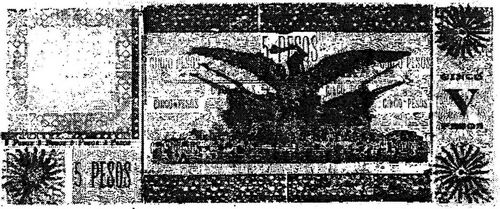
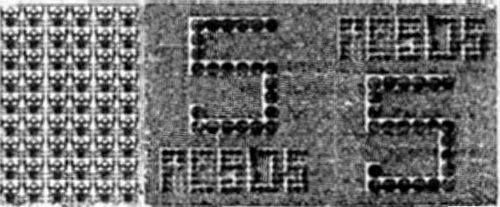
The background of the face of the note includes a combination of ornamental types and the denomination repeated in one form or another thirteen times, plus a cut of the National Arms flanked by flags and cannon. The reverse background is entirely of ornamental type, some of which has been arranged to "spell" the denomination twice. These underprints were reset at least a few times, as evidenced by changes in the orientation of some of the ornamental types and differences in the three circular floral elements in the corners of the front.
"Key" Plates
In typography, the term "key plate" refers to a plate used in combination with other plates to produce more than one job (or in this case for more than one denomination of note) without having changes made to it. For these Oaxaca notes, the key plate for the face consisted of a border, all text other than the denomination (including the printer's imprint at the bottom below the frame), and a circular seal. The plate for the back has printed text and a portrait of Benito Juárez. For the 1 peso this printing is in green, while for the 5 pesos it is blue.
These plates underwent numerous changes, but they are all ones that are not denomination-specific and will generally be found on both. On the front the most frequent change was the printing date, but changes were also more occasionally made involving the circular seal, the inscription below the frame which can show OAXACA spelled out or abbreviated, and to the frame, itself. On the back, the changes include varieties of the Juárez portrait and changes in the decree number and date. Shown below are the front and back of a note (simulation) showing only the portion of the printing made with the key plates.
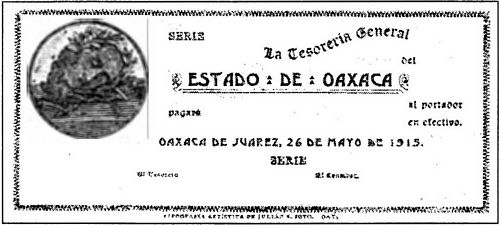
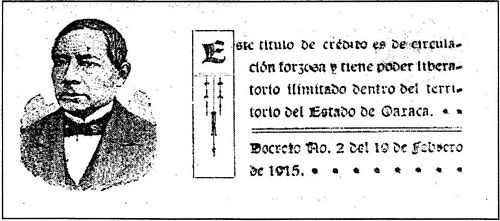
The circular seal at the left side of the face key plate is said to show the head of the Zapotec Princess Donaji - a state symbolThe official seal (escudo) of the city of Oaxaca de Juárez represents the reclined head of Princess Donaji. In the center is the head of a young and beautiful woman in horizontal position surrounded by laurel leaves. From her ear sprouts the branch of a lily whose violet flower curves over her forehead. It is inspired by the legend of the daughter of the Zapotec king Cocijoeza. The story goes that after a war between the Mixtecs and Zapotecs, the Mixtecs held Monte Alban and dominated the region. As a guarantee of peace, the Mixtecs demanded a royal hostage - the princess Donaji. Though received with honors befitting her rank, Donaji felt the humiliation of her people and sent word that they should attack regardless of the fact that her own life would be jeopardized. The attack was successful, but not before the Mixtecs beheaded Donaji and disposed of her body. Sometime later, a beautiful purple iris was found along a river bank, and beneath it was found the head of the princess, still beautiful and seemingly asleep, iris roots on her right temple and forehead. Regardless of whether this folklore has any basis in history, Donaji has been embraced as a symbol of Oaxaca, representing the dedication and spirit of self-sacrifice of her people.. It comes in two types whose differences on close examination are fairly obvious. The shading of the nose is a particularly useful point of comparison, as are the distances between points on the wreath and the circle. Type 1 was replaced during the 24 February 1915 printings.
The Juárez portrait and authorization decree were printed on the back in the same colour. There are two different decree numbers and dates found on the 1 peso notes and four different on the 5 pesos (though one of these appears to be a transposition-error). There are three types of Juárez portrait, shown below. The first is known as the "Old Juárez" portrait, while the other two are the "Young Juárez." Each can be readily differentiated by comparing the shape of the shadow above Juárez' shoulders.
 |
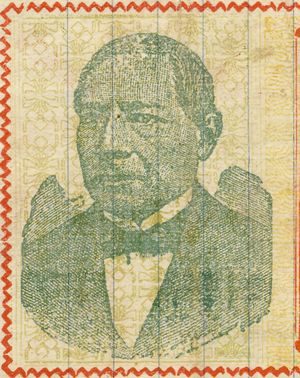 |
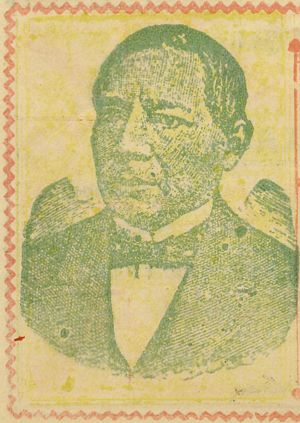 |
| Type 1 | Type 2 | Type 3 |
Starting with the printings dated 10 August 1915, the bottom inscription on the front was changed so that OAXACA is spelled out instead of abbreviated "OAX." The type is also slightly larger. Other changes seem to have occurred in the course of production. Initially the imprint includes accents over the second "I" of "Tipografia" and the ''A" of "Julian" but these disappeared during the 26 Mayo 1915 printings. Normally periods follow SOTO and OAX/OAXACA, but these did not always print. Whether these are typographical varieties or caused by inking or make-ready problems has not been determined
During the second Series P printing of the 24 September 1915 1 peso, the border was changed from a sawtooth rule to a double line, one wavy. On the 5 pesos the change is first seen on the 15 November 1915 notes.
Denomination ("Duty" or "Overprint") Plate
Next, the denomination, together with some ornaments, was printed. On the 1 peso this is in red, while on the 5 pesos this is dark green. For notes with serial numbers over one million, a "l" was included twice in the plate to precede the other six digits which were applied with numbering devices. The same colors were used to print a border on the reverse as well as a vertical double bar to the right of the Juarez portrait. There is some variation in the appearance and placement of this bar.
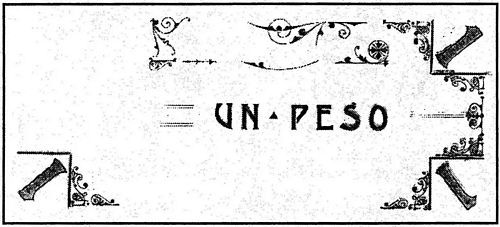
These type elements were shared by the different denominations, so the plate was reset many times. One element in the "UN PESO" typesetting that bears attention is the small triangle between the words. Usually, but not always, this points up. The change may have been intended as a control.


The face of the note was completed with the printing of the signatures of José Zorilla, Treasurer, and Manuel Velasco, Accountant, plus the series letter, all in black, and the serial number in red or, in the case of 5 pesos notes numbered one million or higher, in green. The letters used were J-U-A-R-E-Z, later P-D-I-A-Z, and Y (for the next to last 5 pesos printing in 1915). Juárez and Porfirio Díaz were both native to Oaxaca. The significance of the letter Y is not clear. At first, the letters JUAREZ were employed without repetition for notes sharing the same date. The first printings of the 1 peso, all dated 24 February 1915 bear the letters U, R and Z (each representing a separate printing) while the 5 pesos notes with the same date bear the letters J, A, and E. They probably alternated the production of the two denominations so the letters appeared in the order: J, U, A, R, E, Z. A printing could have consisted of anything from a few thousand notes to well over 100,000. The next printings, dated 20 April 1915, utilize the same letters in a different order - 1 peso: J, A, and E, and the 5 pesos: R, U, and Z. The six printings dated 26 May 1915 (also consisting of three for each denomination) used the same letters in yet a different order. The same is true for the next two printings, though for the 26 June printings there was a fourth run of 1 peso resulting in the letter A being used twice. After that, the PDIAZ set of letters was used, the scheme being extended to the 10 pesos and 20 pesos. Subsequent 1915 printings used these letters, with repetitions and the introduction of the letter Y to the 5 pesos printings. In 1916 only 5 and 10 pesos notes were produced. For the 5 pesos, the JUAREZ set of letters was used but apparently in a random manner.
Signatures
|
José Zorrilla Tejada came from an important Oaxacan family and was a businessman and consejero of the Banco de Oaxaca. He was Presidente Municipal in 1904 and served as a federal deputy. In 1902 he was president of the Club Central Unión y Paz which supported Emilio Pimentel’s bid for the governorship and in 1910 was president of the Club Central Reeleccionista, which supported President Díaz. In 1915 he served as Tesorero General to governor José Inés Dávila, when the latter was asserting the state’s sovereignty. For this he was arrested and briefly detained before being released to home detention in July 1916AMOax, Gobierno Preconstitucionalista 1916, Comunicaciones con el alcaide sobre diversos reos. |
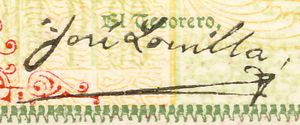 |
| Manuel Velasco was a career employee in the Tesorería y Dirección General de Rentas. He was signing balance sheets for the Contador in July 1906Periódico Oficial, Tomo XXVI, Núm. 55, 11 July 1906 and November 1912Periódico Oficial, Tomo XXXII, Núm. 91, 13 November 1912 and was Contador by November 1913Periódico Oficial, Tomo XXXIV, Núm. 3, 10 January 1914. | 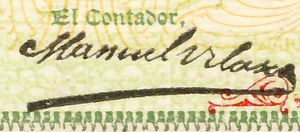 |
Treasury Seal
The back of the note was completed with the printing of the Treasury Seal. The position of this seal was changed with each printing, no doubt as a control device to make it more likely that a forgery could be detected since, presumably, a forger would not be aware of the correlation between seal position and the letter-series and serial number. The seal is in red except on 5 pesos notes with serial numbers over one million - then it is green. On rare occasions, the position of the seal was changed during the course of a specific printing (seen mainly on later 5 pesos printings).
The various positions in which the seal may be found on the backs of 1 peso and 5 pesos notes are shown in the following diagram:
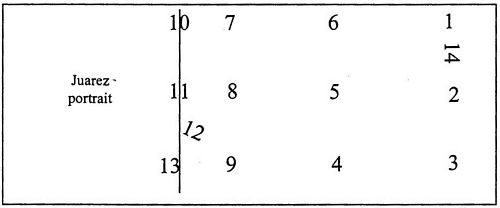
Paper
So far, at least twenty-nine different papers have been identified. Not only do papers differ in colour, texture, thickness and the presence or absence of ledger-lines in various colors and layouts, but several different watermarks have been seen: AZTEC BONDAztec Bond paper was produced by Diem & Wing Paper Company of Cincinnati, Ohio, SATURNO, WHITEHALL, ORIGINAL, "Mexico", CAMBRIO BOND, VOUCHER BOND, BROTHER JONATHAN BOND, "_doer Mills", "_abasa Alvarez", 1810 - 1910 (with image of Hidalgo), and portions of unidentified watermark/s with serifed double-lined letters "CA", etc. A thick ribbed paper has been found on the 5 pesos and various laid papers on both values (which appear to be scarce to rare). Papers will be described more carefully in the following list by denomination and printing.
